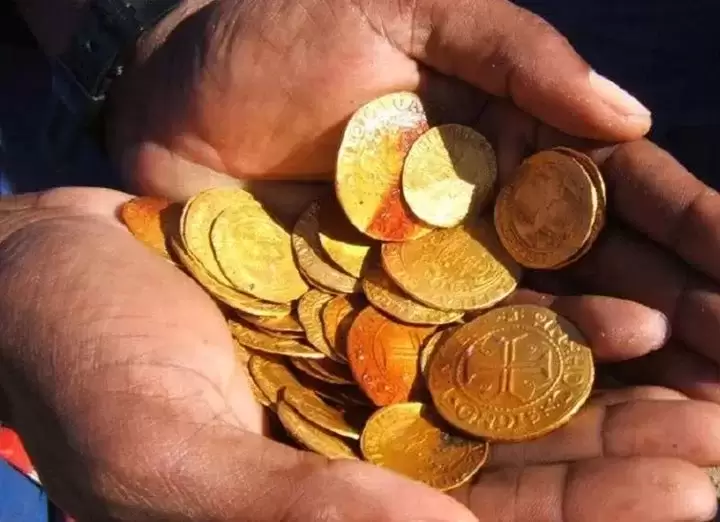 |
|
 |
|
 |
|
 |
|
 |
|
 |
|
 |
|
 |
|
 |
|
 |
|
 |
|
 |
|
 |
|
 |
|
 |
|
1533年に失われたポルトガルの船は、ナミビアの砂漠に再浮上し、コイン、インゴット、そして世界的な貿易史を垣間見る宝庫を提供しました。ケレ・ジョンソン。

A Portuguese vessel lost in 1533 has recently resurfaced in Namibia’s desert, offering a treasure trove of coins, ingots, and a glimpse into global trade history.
1533年に失われたポルトガルの船は、最近ナミビアの砂漠に再浮上し、コイン、インゴット、そして世界的な貿易史を垣間見る宝庫を提供しています。
Miners searching for diamonds in one of the most unlikely places on earth—the blazing sands of the Namib Desert—uncovered a time capsule from the Age of Discovery. They were working on a new section of the diamond mine in 2008 when they unearthed the remains of the Bom Jesus (which translates to “The Good Jesus”), a Portuguese trading vessel lost at sea nearly 500 years ago. The final voyage had ended, but not in the waters off the coast of Africa. It had ended inland, where the desert meets the Atlantic coast.
地球上で最もありそうもない場所の1つであるナミブ砂漠の燃える砂の1つでダイヤモンドを探している鉱山労働者は、発見の時代からタイムカプセルを覆いました。彼らは、500年近く前に海で失われたポルトガルの貿易船であるボム・イエスの遺跡(「良いイエス」に翻訳される)を発掘した2008年にダイヤモンド鉱山の新しいセクションに取り組んでいました。最終的な航海は終了しましたが、アフリカの海岸沖の水域では終わりませんでした。砂漠が大西洋沿岸と出会う内陸で終わりました。
And it was filled with treasure.
そして、それは宝物に満ちていました。
The Bom Jesus was a Portuguese nau (also called a Carrack) that departed Lisbon on Friday, March 7, 1533, captained by Sir Francico de Noronha, bound for the lucrative trade routes of the East. The ship’s fate remained a mystery for centuries—until 2008, when diamond miners discovered its wreck near Oranjemund on Namibia’s Atlantic coast. Its discovery marked a milestone in maritime archaeology: the Bom Jesus is now considered the oldest and most significant shipwreck found along the western edge of Sub-Saharan Africa.
ボム・イエスは、1533年3月7日金曜日にリスボンを去ったポルトガル語のナウ(キャラックとも呼ばれます)であり、イーストの有利な貿易ルートに縛られているフランシコ・デ・ノーニャirがキャプテンしました。船の運命は何世紀にもわたって謎のままでした。2008年まで、ダイヤモンドマイナーがナミビアの大西洋沿岸のオランジェムンドの近くで難破船を発見しました。その発見は、海事考古学のマイルストーンをマークしました。ボムイエスは、サハラ以南のアフリカの西端に沿って見られる最も古く、最も重要な難破船と見なされています。
Built in the early 16th century during Portugal’s golden age of exploration, the Bom Jesus likely belonged to a new generation of ships designed to endure the long and perilous voyages between Europe and Asia. These naus were built larger and sturdier than earlier vessels, being built to withstand the treacherous passage around the Cape of Good Hope and back.
16世紀初頭にポルトガルの黄金時代の探検の間に建てられたボムイエスは、ヨーロッパとアジアの間の長く危険な航海に耐えるように設計された新世代の船に属している可能性があります。これらの騒ぎは、以前の船よりも大きく頑丈な建設されており、希望と背中の岬の周りの危険な通路に耐えるために建てられています。
The hull of the Bom Jesus was constructed using advanced shipbuilding techniques for the time. It was a vessel of considerable size and draft, a testament to the Portuguese prowess in shipbuilding during the Age of Discovery.
ボム・イエスの船体は、当時高度な造船技術を使用して建設されました。それはかなりのサイズと草案の容器であり、発見時代の造船におけるポルトガルの才能の証です。
Although little documentation of the ship survives, experts believe the Bom Jesus was headed for the Indian subcontinent, carrying a cargo tailored for trade.
船の文書はほとんど生き残っていませんが、専門家は、ボム・イエスが貿易に合わせた貨物を運んでいるインド亜大陸に向かっていると信じています。
The archaeologists called to the site uncovered an staggering hoard. Approximately 2,000 gold coins were recovered from the site, predominantly Spanish excellentes featuring the likenesses of Isabella I of Castile and Ferdinand II of Aragon. Portuguese coinage was also present, including cruzados from the reigns of Kings Manuel I and João III. Additionally, coins from Venice, France, and various Muslim states were found, indicative of the extensive trade connections of the period. The inscriptions and designs on these coins were instrumental in dating the shipwreck to the early 1530s.
考古学者は、サイトに電話をかけて、驚異的な貯蔵庫を明らかにしました。約2,000個の金貨がサイトから回収されました。これは、主にスペイン語の優秀さを、カスティーリャのイザベラ1世とアラゴンのフェルディナンド2世の肖像を特徴としています。キングスマヌエル1世とジョアン3世の統治からのクルザドを含むポルトガルの貨幣も存在しました。さらに、ヴェネツィア、フランス、およびさまざまなイスラム教徒の州からのコインが見つかりました。これは、この時代の広範な貿易関係を示しています。これらのコインの碑文とデザインは、1530年代初期に難破船とデートするのに役立ちました。
Another surprise came in bulk. The find included 1,845 copper ingots, each stamped with a trident mark linking them to the powerful Fugger banking family of Germany, which were found amidst the wreckage. These ingots, weighing some 17 tons, had originally been shipped from Central Europe and were headed for India, where copper was a prized trade commodity. The Fuggers’ mark made this historical find even richer, providing substantial proof of copper’s role in global commerce and the Fugger family’s significant role in supplying copper for trade during the Renaissance.
別の驚きが大量に来ました。発見には、1,845個の銅インゴットが含まれており、それぞれにトライデントマークが刻印されており、それらをドイツの強力なファガー銀行ファミリーにリンクしていました。体重は約17トンのこれらのインゴットは、もともと中央ヨーロッパから出荷され、銅が貴重な貿易商品であったインドに向かいました。 Fuggersのマークは、この歴史的な発見をさらに豊かにし、グローバルな商業における銅の役割と、ルネッサンス中の貿易のために銅を供給する際のファガー家の重要な役割を実質的に証明しました。
The preservation was extraordinary. While only a small part of the wreck’s original structure was preserved, the ship’s contents were found in relatively good condition. Namibia’s dry climate and the heavy copper cargo helped create a sealed environment, protecting not just the metal but also elephant tusks, navigational instruments, weapons (including a 500-year-old musket and cannons), and personal effects—all eerily well-preserved.
保存は並外れたものでした。難破船の元の構造のごく一部しか保存されていませんでしたが、船の内容は比較的良好な状態で発見されました。ナミビアの乾燥した気候と重い銅貨物は、金属だけでなく、象の牙、航海楽器、武器(500年前のマスケット銃や大砲を含む)、および個人的な効果を保護し、封印された環境を保護しました。
Dr. Dieter Noli, the lead archaeologist at the South African Institute for Maritime Archaeological Research, maintains that the copper ingots were responsible for the remarkable preservation of the ship’s cargo. “Marine organisms may like wood, book covers, peach pits, jute sacks, and leather shoes, but copper really repels them from their food – so a lot of things survived 500 years at the bottom of the sea that really shouldn’t have.”
南アフリカ海事考古学研究所の主任考古学者であるディーター・ノリ博士は、銅のインゴットが船の貨物の顕著な保存の原因であると主張しています。 「海洋生物は木材、本のカバー、桃の穴、ジュート袋、革の靴が好きかもしれませんが、銅は本当に彼らの食べ物からそれらを撃退します。そのため、多くのことが海の底で500年生き延びました。」
The find is the stuff of legend for treasure hunters and history buffs. For numismatists, it’s a windfall of study materials and historical significance.
発見は、トレジャーハンターと歴史愛好家の伝説のものです。貨幣主義者にとって、それは研究資料と歴史的重要性の吹き出物です。
Seventeen years after its discovery, the exact fate of the Bom Jesus and how it came to rest in Namibia is still uncertain. The prevailing theory is that a violent storm pushed the ship toward the coast, where it ran aground.
その発見から17年後、ボム・イエスの正確な運命とナミビアでの休息がどのようになったかはまだ不確実です。一般的な理論は、暴力的な嵐が船を海岸に向かって押したということです。
Though many items remain in conservation, plans are to exhibit the Bom Jesus artifacts to the public eventually. In the meantime, the find continues to offer new clues about a time when ships like the Bom Jesus helped stitch together a truly global economy.
多くのアイテムは保全に残っていますが、計画は最終的には一般の人々にボムイエスのアーティファクトを展示することです。それまでの間、この発見は、ボム・イエスのような船が真にグローバルな経済をつなぎ合わせるのを助けた時期についての新しい手がかりを提供し続けています。
免責事項:info@kdj.com
提供される情報は取引に関するアドバイスではありません。 kdj.com は、この記事で提供される情報に基づいて行われた投資に対して一切の責任を負いません。暗号通貨は変動性が高いため、十分な調査を行った上で慎重に投資することを強くお勧めします。
このウェブサイトで使用されているコンテンツが著作権を侵害していると思われる場合は、直ちに当社 (info@kdj.com) までご連絡ください。速やかに削除させていただきます。





























































